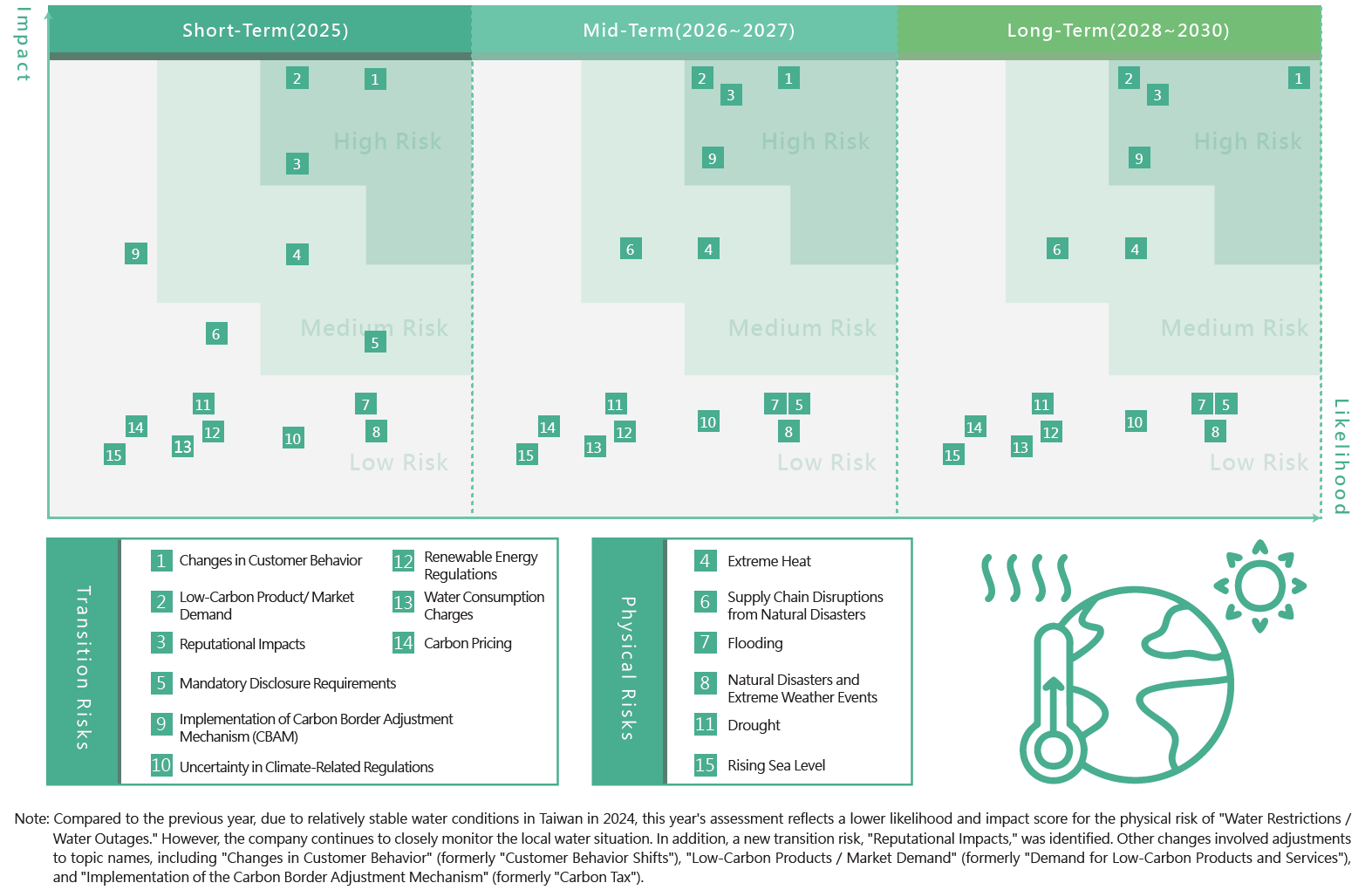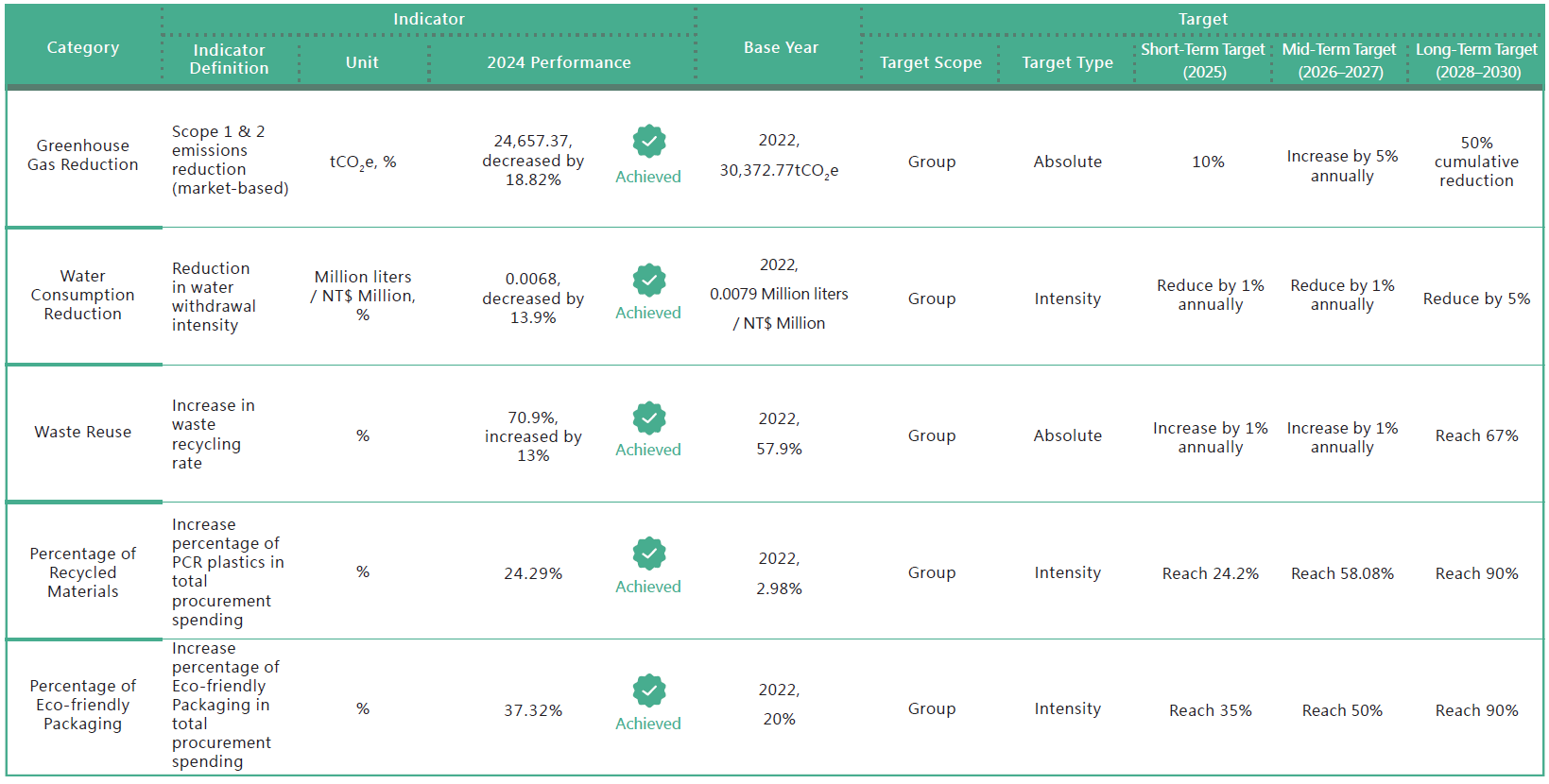Corporate success and environmental health are deeply interconnected. Gemtek Technology not only complies with all applicable environmental regulations but also actively engages in green initiatives. The company is committed to energy conservation, carbon reduction, and resource recycling, integrating environmental awareness into daily operations to minimize the environmental impact of its business activities. Implement environmental protection policies across multiple operational aspects, including but not limited to reducing energy and resource consumption, optimizing production processes to minimize waste, promoting a cir cular economy, and supporting the use of sus tainable energy.
Environmental Sustainability Policy
- Energy Consumption and Greenhouse Gases: Continually enhance the energy management system and its performance to reduce energy consumption and greenhouse gas emissions.
- Implement effective energy management to achieve carbon reduction targets.
- Ensure compliance with energy regulations and relevant standards, and promote the development of green products.
- Adopt renewable energy sources to support carbon reduction efforts.
- Promote resource recycling and implement proactive source reduction measures.
- Deliver information and resources to drive progress toward organizational goals.
- Water Discharge and Reuse: Reduce water consumption and ensure proper water treatment.
- Air Pollution Control: Reduce air pollutant emissions and avoid procuring ozone-depleting substances to minimize environmental impact.
- Raw Materials, Chemicals, and Waste: Reduce the use of raw materials and the production of hazardous waste.
- Environmental Impacts During Product Use: Minimize the environmental impact of products during their usage phase.
- Environmental Impacts During End-of-Life: Maximize product recycling and reuse.
- Consumer Health and Safety: Ensure that products pose no threat to consumer health or safety.
Task Force on Climate Related Financial Disclosures (TCFD)
Gemtek Technology follows the four core elements of the Task Force on Climate-related Financial Disclosures (TCFD) framework—Governance, Strategy, Risk Management, and Metrics and Targets—to identify climate-related risks and opportunities, assess their impact on the company’s operations and financial performance, and develop corresponding response strategies and action plans to strengthen the company’s resilience to climate risks.
Governance
In 2023, Gemtek Technology established a Sustainable Development Committee, composed of the General Manager, Chief Financial Officer, and three Independent Directors, with the General Manager serving as the convener. The committee meets at least once a year and regularly reports to the Board on climate-related initiatives, targets, and performance to ensure the continuity and transparency of sustainability efforts, while regularly reviewing and adjusting response strategies as needed.
In 2024, the committee convened four times to review the results of the 2023 greenhouse gas inventory, stakeholder engagement outcomes, the annual sustainability plan, and its implementation progress.
Risk Management
Guided by the TCFD framework, aligning with the IFRS S2 climate-related disclosure requirements, Gemtek Technology evaluated domestic and international regulatory trends, sustainability strategies, customer expectations, and market developments to identify and categorize 15 climate-related risk topics relevant to the company. These include 10 transition risks and 5 physical risks.
Gemtek conducted its 2024 climate risk assessment using two key evaluation factors: likelihood and financial impact. The assessments were aligned with the company’s sustainability timelines and categorized into short-term (2025), mid-term (2026 to 2027), and long-term (2028 to 2030) periods. For each climate risk scenario, the company assessed the level of exposure, corresponding response strategies, and expected benefits, and assigned scores for both likelihood and financial impact using a defined risk scale.
In 2024, four primary climate-related risks were identified: Low-Carbon Product / Market Demand, Changes in Customer Behavior, Reputational Impacts, and the Implementation of the Carbon Border Adjustment Mechanism (CBAM). During the assessment process, the company also identified one key opportunity: Entry into New Markets. The results of the climate risk and opportunity assessment, along with the corresponding response strategies, were reported to the Sustainable Development Committee and the Board of Directors in June 2025 and will continue to be reviewed and adjusted on a regular basis.
Climate Risk Matrix (Short-Term / Mid-Term / Long-Term)

-
Climate Scenario Analysis
In 2024, Gemtek Technology incorporated scenario analysis as a reference framework for identifying climate-related risks and opportunities. For transition risks, the company based its analysis on scenarios outlined in the World Energy Outlook 2024 (WEO 2024), published by the International Energy Agency (IEA), adopting the "Net Zero Emissions by 2050" (NZE) and "Stated Policies Scenario" (STEPS) as baseline assumptions. For physical risks, the company referred to the greenhouse gas emissions scenarios presented in the Sixth Assessment Report (AR6) released in 2021 by the Intergovernmental Panel on Climate Change (IPCC), using SSP1-1.9, SSP1-2.6, and SSP5-8.5 for the scenario analysis.
| Scope of Assessment |
Applicable Risk |
Reference | Scenario | Description |
| Gemtek TechnologyNote |
Transition Risks |
IEA WEO 2024 |
NZE by 2050) |
This scenario outlines a pathway for the global energy sector to achieve net-zero emissions by 2050 without relying on external carbon offset mechanisms. It offers a greater than 50% probability of keeping the global average temperature increase below 1.5°C by 2100. The NZE scenario is consistent with the Paris Agreement objective of limiting global warming to below 1.5°C by the end of this century. |
| STEPS (Stated Policies Scenario) |
This scenario is based on the decarbonization policies currently implemented by countries around the world and projects the likely development of future energy systems. Under this scenario, the goal of achieving net-zero emissions by 2050 would not be attainable. | |||
| Gemtek Technology and Key Suppliers |
Physical Risks |
IPCC AR6 | SSP1-1.9 (Very Low Emissions Scenario) |
This scenario aims to keep the global average temperature rise below 1.5°C and has a greater than 50% chance of meeting this goal. This requires large-scale emission reduction efforts and the achievement of net-zero greenhouse gas emissions by around 2050. |
| SSP1-2.6 (Low Emissions Scenario) |
This scenario aims to limit the global temperature rise to within 1.5°C, with emissions expected to decline significantly over the coming decades. However, the probability of achieving this scenario is slightly lower compared to SSP1-1.9. | |||
| SSP5-8.5 (Very High Emissions Scenario) |
Under this scenario, there is a greater than 50% probability that global temperatures will rise by more than 4°C by 2100. Greenhouse gas emissions are estimated to double by 2050 relative to current levels and to triple by 2100. |
Note: The assessment scope covers three operational sites: Gemtek's Taiwan Headquarters, the Gemtek (Kunshan) facility, and the Gemtek Vietnam facility.
Strategy
Identification of Key Climate Risks and Opportunities
| Category | Risk/Opportunity Source |
Description of Impact on Gemtek | Response Strategy | Category |
| Transition Risk |
Market- Changes in |
As a global supplier of network communication products, Gemtek requires a substantial volume of raw materials, with plastics accounting for at least one-third of the total. While certain models incorporate post-consumer recycled (PCR) plastics as specified by customers, most still rely on single-use, petroleum-based plastics. In an era of heightened environmental awareness, one of the company′s major challenges is how to respond to future restrictions on single-use plastics and rising PCR material costs, while also meeting customer expectations for green products such as carbon management and carbon footprint tracking, in order to avoid the risk of losing orders due to delayed transformation. |
|
|
| Transition Risk |
Technology- Low-carbon |
As global discussions on net-zero carbon emissions continue to gain momentum, low-carbon products have emerged as a key direction for future development. In response to this market t rend, Gemtek is actively developing environmentally friendly and sustainable products and services, strengthening energy-efficient technologies, and adopting efficient manufacturing processes to reduce carbon emissions and enhance the market competitiveness of its products. | ||
| Opportunity |
Market- Entering new |
As global awareness of carbon reduction continues to rise, regulatory requirements and market trends are leading to growing customer demand for low-carbon products and the use of renewable energy. In response, Gemtek is actively investing in the research and development of wind power equipment to meet current customer expectations, enhance product competitiveness, and explore new market opportunities. | ||
| Transition Risk |
Regulatory- Implementation |
Under current EU regulations, the Carbon Border Adjustment Mechanism (CBAM) is expected to be gradually implemented across various industries starting in 2026, imposing tariffs on products entering the EU market. Approximately 30% of Gemtek′s products are sold directly or ultimately to Europe each year and contain raw materials subject to carbon tariff reporting. This poses potential risks, including the need to pay applicable tariffs or absorb costs passed on by customers. In 2025, Gemtek will conduct data analysis and simulations, actively engage in customer negotiations, and continue to monitor future regulatory developments. |
|
|
| Transition Risk |
Reputation- Corporate |
Under current EU regulations, the Carbon Border Adjustment Mechanism (CBAM) is expected to be gradually implemented across various industries starting in 2026, imposing tariffs on products entering the EU market. Approximately 30% of Gemtek′s products are sold directly or ultimately to Europe each year and contain raw materials subject to carbon tariff reporting. This poses potential risks, including the need to pay applicable tariffs or absorb costs passed on by customers. In 2025, Gemtek will conduct data analysis and simulations, actively engage in customer negotiations, and continue to monitor future regulatory developments. |
|
|
Targets and Indicators
To effectively manage its climate response strategy, Gemtek Technology has committed to achieving net-zero emissions by 2050. With 2022 as the base year, the company has established corresponding indicators and targets, which are reviewed on a regular basis. The General Manager reports progress and outcomes to the Sustainable Development Committee and the Board of Directors. Over the long term, the company will continue to monitor and implement corrective actions as necessary. The relevant indicators and their short-, medium-, and long-term targets are outlined below.
Gemtek Technology's Climate Targets and Indicators




